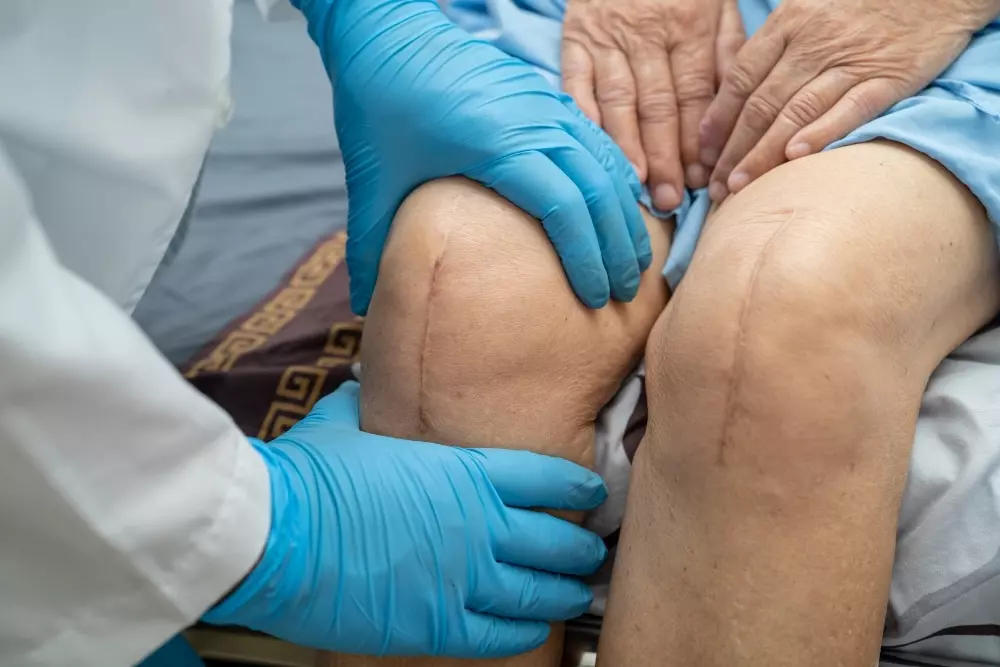Understanding Total Knee Replacement
Total Knee Replacement is a life-changing surgical procedure designed to relieve chronic knee pain and restore function to damaged joints. It involves replacing the worn or injured parts of the knee with artificial components that mimic the natural movement of a healthy knee. This surgery has become one of the most successful and commonly performed orthopedic procedures worldwide. The main goal is to allow patients to walk, climb stairs, and return to an active lifestyle without constant discomfort. For individuals who have been struggling with limited mobility, stiffness, or persistent pain caused by arthritis or injury, Total Knee Replacement offers a second chance at living comfortably. It’s not only about regaining movement but also about improving quality of life and independence. With advanced medical technology, today’s procedures are safer, less invasive, and deliver better long-term results than ever before.
Common Reasons for Total Knee Replacement
Several conditions can lead to severe knee damage that requires surgical intervention. The most common is osteoarthritis, a degenerative joint disease that wears down cartilage and causes bones to rub together. Rheumatoid arthritis, on the other hand, leads to inflammation that destroys joint tissue. Post-traumatic arthritis can develop after a fracture or injury that alters the alignment of the knee. Over time, pain becomes unbearable, and walking, bending, or even sitting for long periods becomes difficult. When medications, physical therapy, or injections no longer provide relief, Total Knee Replacement becomes the best option. Patients often experience pain even during rest, making everyday activities almost impossible. It’s a decision that brings back comfort, mobility, and confidence to move freely again.
Who Is a Good Candidate for the Procedure
Not everyone with knee pain immediately qualifies for surgery. Doctors first assess whether the damage is severe enough to require replacement. Ideal candidates are usually adults over 50 who suffer from advanced arthritis or significant joint deterioration. They may have difficulty performing simple tasks like climbing stairs, getting out of chairs, or walking short distances. Before surgery, specialists conduct X-rays, MRI scans, and physical evaluations to measure bone structure and alignment. Factors such as overall health, weight, and lifestyle habits also influence eligibility. Conditions like uncontrolled diabetes or heart disease may delay surgery until the patient is medically stable. The key is to determine whether the potential benefits outweigh the risks, ensuring that each patient is physically and mentally ready for recovery.
How the Surgery Works
Total Knee Replacement surgery typically takes one to two hours and is performed under anesthesia. The orthopedic surgeon makes a precise incision to access the knee joint, removes the damaged cartilage and bone surfaces, and replaces them with artificial components made of metal alloys and durable plastic. These parts are shaped to fit perfectly, ensuring smooth motion similar to a natural joint. The new knee is designed to last 15 to 20 years or more, depending on activity levels and implant quality. Advanced techniques such as robotic-assisted surgery allow surgeons to make smaller incisions and achieve highly accurate alignment, reducing recovery time. With minimally invasive approaches, patients experience less pain and faster rehabilitation. The combination of expert skill and technology ensures safer, more consistent outcomes for those undergoing the procedure.
Preparing for Total Knee Replacement
Preparation plays a crucial role in achieving a successful outcome. Doctors may recommend several pre-surgery steps, including lifestyle adjustments, physical therapy, and dietary improvements. Patients are often advised to strengthen their leg muscles to support post-surgical recovery. Medical clearance from specialists ensures that the heart, lungs, and other vital organs are ready for anesthesia. Home preparation is equally important — setting up a safe environment with supportive furniture and minimizing fall risks helps with smoother recovery. Emotional readiness is also vital, as anxiety before surgery can affect healing. Patients should discuss concerns with their healthcare team to understand every stage of the process.
Here’s what to prepare before surgery:
- Schedule preoperative tests and clearances.
- Practice mobility exercises recommended by a physical therapist.
- Arrange home assistance for the first few weeks after surgery.
- Prepare loose, comfortable clothing for rehabilitation.
- Follow dietary and medication adjustments prescribed by the doctor.
With these preparations, patients enter surgery feeling informed, confident, and ready for a new phase of mobility.
What to Expect After Surgery
After the operation, patients spend several days in the hospital for observation and pain management. Physical therapy begins almost immediately, helping patients start gentle movements to regain flexibility. Swelling, soreness, and stiffness are normal during the first weeks, but consistent exercises help restore mobility faster. Most people can walk with assistance within a few days and gradually transition to a cane or crutch. Pain medications and cold therapy are used to control discomfort and inflammation. The hospital stay usually lasts two to four days, depending on progress. Once home, patients continue with a structured rehabilitation plan to strengthen muscles and increase range of motion. Regular follow-ups with the surgeon ensure proper healing and implant positioning.
Recovery and Long-Term Outcomes
Recovery from Total Knee Replacement is a gradual process that can take several months, but the results are worth the effort. The first six weeks are critical for physical therapy and mobility training. Most patients regain the ability to walk comfortably and perform light household tasks after two months. Full recovery typically occurs within six months, depending on the individual’s dedication to rehabilitation. Long-term success depends on maintaining a healthy weight, staying active, and avoiding high-impact sports. With proper care, an artificial knee joint can last for decades, allowing patients to enjoy a pain-free life. For many, this procedure marks the end of years of discomfort and limited movement. The reward is renewed independence and the ability to return to favorite hobbies and daily routines without restriction.
Potential Risks and Complications
Like any major surgery, Total Knee Replacement carries certain risks. These may include infection, blood clots, or allergic reactions to anesthesia. Although rare, complications like implant loosening or stiffness can occur over time. Surgeons take every precaution to prevent such issues by maintaining sterile environments and using advanced surgical techniques. Patients can reduce their risks by following medical advice carefully and staying active after recovery. It’s essential to recognize warning signs such as severe swelling, redness, or persistent pain, which may require immediate attention. Early intervention can resolve most problems before they worsen. With modern healthcare standards and experienced orthopedic specialists, the success rate for Total Knee Replacement remains remarkably high.
Cost and Insurance Coverage
The cost of Total Knee Replacement varies depending on the hospital, surgeon’s expertise, and location. In the United States, the average cost ranges from $35,000 to $70,000. This typically includes the surgeon’s fee, hospital stay, anesthesia, implants, and physical therapy. Many insurance providers cover part or all of the expense if the surgery is deemed medically necessary. Patients are encouraged to consult with both their surgeon and insurance company to understand coverage details. It’s also wise to prepare for out-of-pocket expenses such as medication, post-surgery equipment, or extended rehabilitation. Some hospitals offer payment plans or financing options to make the procedure more accessible. Knowing these financial details ahead of time helps patients plan confidently without unexpected surprises.
Advances in Total Knee Replacement Technology
Medical innovation has significantly transformed Total Knee Replacement in recent years. Robotic-assisted systems enable surgeons to perform procedures with higher precision and less tissue damage. 3D imaging allows for customized implants that perfectly match a patient’s anatomy, improving comfort and longevity. New materials like highly cross-linked polyethylene and titanium alloys enhance durability while mimicking natural joint movement. Minimally invasive surgical techniques also result in smaller scars, less blood loss, and faster recovery. These advancements not only improve the success rate but also help patients return to normal activities sooner. The combination of skilled professionals and technology continues to redefine what’s possible in orthopedic care.
Living with a New Knee
After recovery, patients often describe the experience as transformative. Daily activities become easier, and pain that once limited movement fades away. It’s important, however, to maintain healthy habits that protect the new joint. Low-impact exercises like swimming, cycling, and walking are recommended to strengthen muscles and improve flexibility. Avoiding high-impact sports helps prevent unnecessary wear on the artificial knee. Nutrition also plays a role in long-term success; maintaining a balanced diet supports joint health and overall well-being. Regular follow-up visits allow doctors to monitor implant condition and address any emerging concerns early. Emotionally, regaining independence can have a profound effect, boosting confidence and overall happiness.
Frequently Asked Questions (FAQ)
How long does a Total Knee Replacement last?
Most knee replacements last 15 to 20 years, depending on activity level and implant quality. Some can last even longer with proper care.
When can I return to work or drive after surgery?
Patients can usually resume driving within six to eight weeks, depending on recovery speed and which leg was operated on.
Can both knees be replaced at the same time?
Yes, it’s possible through a bilateral knee replacement, but it depends on overall health and physical condition.
What activities should I avoid after surgery?
Avoid high-impact sports like running, basketball, or jumping to prevent excessive wear on the implant.
How painful is the recovery process?
Pain levels vary, but most patients report manageable discomfort with medication and therapy. The discomfort gradually lessens over time.
Takeaway
Total Knee Replacement offers renewed mobility and freedom from chronic pain for countless people every year. With modern surgical techniques, durable materials, and personalized rehabilitation, patients can look forward to long-lasting comfort and better quality of life. Proper preparation, commitment to recovery, and lifestyle adjustments all contribute to the success of the procedure. For anyone living with constant knee pain, this operation can be the key to moving forward — literally and figuratively — toward a healthier, more active future.






